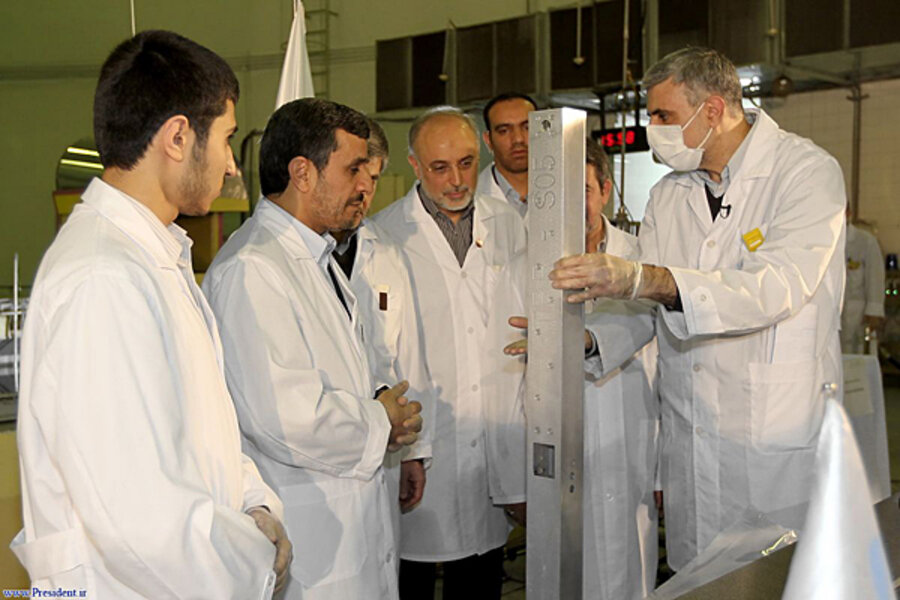Iran nuclear talks: Why there's hope for progress this time
Loading...
| Istanbul, Turkey
As Iran nuclear talks resume on Saturday, diplomats say progress is possible, despite a 15-month hiatus punctuated by an escalation of sanctions, covert war, and talk of a military strike.
Sitting down on one side of the table in Istanbul will be Saeed Jalili, Iran's chief nuclear negotiator, whose job is to not budge on uranium enrichment, but convince six world powers that Iran does not want nuclear weapons, is able to prove it, and that sanctions should be lifted.
On the other side of the table will be Catherine Ashton, the European Union foreign policy chief, representing the so-called P5+1: the US, Russia, China, Britain, France and Germany. Her job – backed up by a host of sanctions that are crippling Iran's economy – is to convince Iran to severely limit its nuclear program, and lay it open to intrusive inspections.
In years past, that same equation has failed several times. But prior to these talks, both sides have signaled a new readiness to deal. And both sides see themselves as negotiating from a position of strength.
"The question is: What is the red line for the P5+1? Is it enrichment? Or a nuclear weapon?" asks Seyed Hossein Mousavian, a former member of Iran's nuclear negotiating team now at Princeton.
"If it is enrichment, there would never be a peaceful solution – never. Ultimately, confrontation is very much possible," says Mr. Mousavian. "If their red line is nuclear weapons, definitely very soon they can reach to an amicable solution, because this is also for Iranians a religious red line."
Iran: Trust 'takes a long time to build'
Unlike previous rounds, both sides say they expect tomorrow's talks to be only the first step, with a second round in Baghdad, perhaps, in a few weeks.
"I don't think they'd be coming if they weren't serious," says a European diplomat in Istanbul. "They've already made signals that are more positive."
Among them was a rare article by Iran's Foreign Minister Ali Akbar Salehi, published in the Washington Post today, in which he repeated Iran's opposition to nuclear weapons, and called on all sides to "make genuine efforts to reestablish confidence and trust."
The "dialogue must be seen as a process rather than an event," Mr. Salehi wrote. "A house can burn to the ground in minutes but takes a long time to build. Similarly, trust can easily and rapidly be broken, but takes a long time to build."
The head of Iran's Atomic Energy Organization, Fereydoun Abbasi Davani, also stated last week that Iran was only enriching uranium to 20 percent in order to fuel a reactor for medical purposes. That level could be stopped when the need was met, and material even turned back to the usual 3.5 percent.
Uranium enriched to 20 percent is not too far, technically, from the 90 percent needed for a weapon, and the West is concerned about Iran developing a stockpile of that higher grade. A key demand of the P5+1 is expected to be Iran verifiably suspending that 20 percent level.
A 'good way to sabotage' the talks
Obama administration officials recently sent a message via Turkey to Iran's Supreme Leader Ayatollah Ali Khamenei that they were willing to accept Iran's nuclear program, if Iran could prove that it rejects the bomb, according to the Post.
"They assert that their program is purely peaceful," said US Secretary of State Hillary Clinton on Thursday. "We want them to demonstrate clearly in the actions they propose that they have truly abandoned any nuclear weapons ambition."
In the past decade, Iran has installed more than 9,000 centrifuges to enrich uranium, mostly to 3.5 percent purity. Some is enriched further, to 20 percent, and much of this work has been moved to a facility called Fordow, buried deeply beneath a mountain and essentially out of range of US and Israeli military strikes.
The New York Times quoted unnamed US officials last week stating that one of their opening positions in the talks was that Iran had to agree to not just halt 20 percent enrichment, but also close down and dismantle Fordow.
Iran immediately pointed out that Fordow is monitored by the United Nations nuclear watchdog agency, and that closing the facility was a non-starter. Iranian sources close to the negotiation team in Istanbul confirmed today to the Monitor that such a demand regarding Fordow would be a deal-breaker – a view also shared by Western analysts.
If that were the P5+1 opening bid, it might be a “good way to sabotage” the talks, wrote Harvard University professor Stephen Walt in an analysis for Foreign Policy this week.
“Remember: Iran has invested millions to build a protected underground enrichment facility, which is what any sensible government might do if it were constantly being threatened with a preventive strike,” wrote Prof. Walt. “It would be an extraordinarily humiliating climb-down for them to agree to shut the facility down at this point and then dismantle it.”
'The Leader doesn't have a problem with any transparency measures'
Still unclear is whether the United States – and by extension the P5+1, and Israel – will accept Iranian enrichment. That's another nonnegotiable point for Tehran, which wants to be treated like any other nuclear power, governed only by the IAEA and not singled out by the UN Security Council.
"Definitely the end package should include rights of Iran to enrichment, normalization of the file in the IAEA and UN, and lifting sanctions," says Mousavian, the former Iranian negotiator.
"If they have these three, they can put in a package the transparency measures to be completely convinced that the Iranian nuclear program in the future will not divert to nuclear weapons. This is the deal," adds Mousavian.
"The Leader [Khamenei] since 2003 has told every negotiation team that he does not have any problem with any transparency measures."







